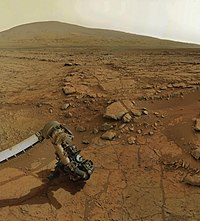
Back Habitabilitat en sistemes de nanes grogues Catalan Habitabilidad en sistemas de enanas amarillas Spanish سکونتپذیری سامانههای کوتوله زرد Persian Sarı cüce sistemlerinin yaşanabilirliği Turkish

 |
| This article is one of a series on: |
| Life in the universe |
|---|
| Outline |
| Planetary habitability in the Solar System |
| Life outside the Solar System |
| Habitability of... |
Habitability of G V stars of G V stars systems defines the suitability for life of exoplanets belonging to yellow dwarf stars. These systems are the object of study among the scientific community because they are considered the most suitable for harboring living organisms, together with those belonging to K-type stars.[1]
Yellow dwarfs comprise the G-type stars of the main sequence, with masses between 0.9 and 1.1 M☉ and surface temperatures between 5000 and 6000 K, like the Sun.[2][3] They are the third most common in the Milky Way Galaxy and the only ones in which the habitable zone coincides completely with the ultraviolet habitable zone.[2][4]
Since the habitable zone is farther away in more massive and luminous stars, the separation between the main star and the inner edge of this region is greater in yellow dwarfs than in red and orange dwarfs.[5] Therefore, planets located in this zone of G-type stars are safe from the intense stellar emissions that occur after their formation and are not as affected by the gravitational influence of their star as those belonging to smaller stellar bodies.[6][7] Thus, all planets in the habitable zone of such stars exceed the tidal locking limit and their rotation is therefore not synchronized with their orbit.[7]
The Earth, orbiting a yellow dwarf, represents the only known example of planetary habitability. For this reason, the main goal in the field of exoplanetology is to find an Earth analog planet that meets its main characteristics, such as size, average temperature and location around a star similar to the Sun.[8][9] However, technological limitations make it difficult to find these objects due to the infrequency of their transits, a consequence of the distance that separates them from their stars or semi-major axis.[10]
- ^ Perryman, 2011, p. 285
- ^ a b Croswell, Ken (1999). Magnificent Universe. Simon & Schuster. p. 80. ISBN 978-0684845944.
- ^ Stellar classification. British Encyclopedia. Retrieved october 8th, 2015.
- ^ Buccino, Andrea P.; Lemarchand, Guillermo A. (2006). "Ultraviolet radiation constraints around the circumstellar habitable zones". Icarus. 183 (2): 491–503. arXiv:astro-ph/0512291. Bibcode:2006Icar..183..491B. doi:10.1016/j.icarus.2006.03.007. hdl:11336/22028. ISSN 0019-1035. S2CID 2241081. Archived from the original on 2015-11-06. Retrieved 2022-05-03.
- ^ Niels Bohr Institute. (2015) Planets in the habitable zone around most stars, calculate researchers Archived 2016-09-15 at the Wayback Machine. Astrobiology Magazine
- ^ Astrobio. (2009) Stars Choose the Life Around Them Archived 2016-03-05 at the Wayback Machine. Astrobiology Magazine
- ^ a b Ulmschneider, 2006 p. 61
- ^ Heller and Armstrong, 2014 p. 50
- ^ Coulter, Dauna; Phillips, Tony. "Getting to Know the Goldilocks Planet". NASA Science. Archived from the original on 2012-03-31. Retrieved 2022-05-03.
- ^ Wall, Mike. "Search for the First True Alien Earth Heats Up". Space.com. Archived from the original on 2023-06-03. Retrieved 2022-05-03.
© MMXXIII Rich X Search. We shall prevail. All rights reserved. Rich X Search